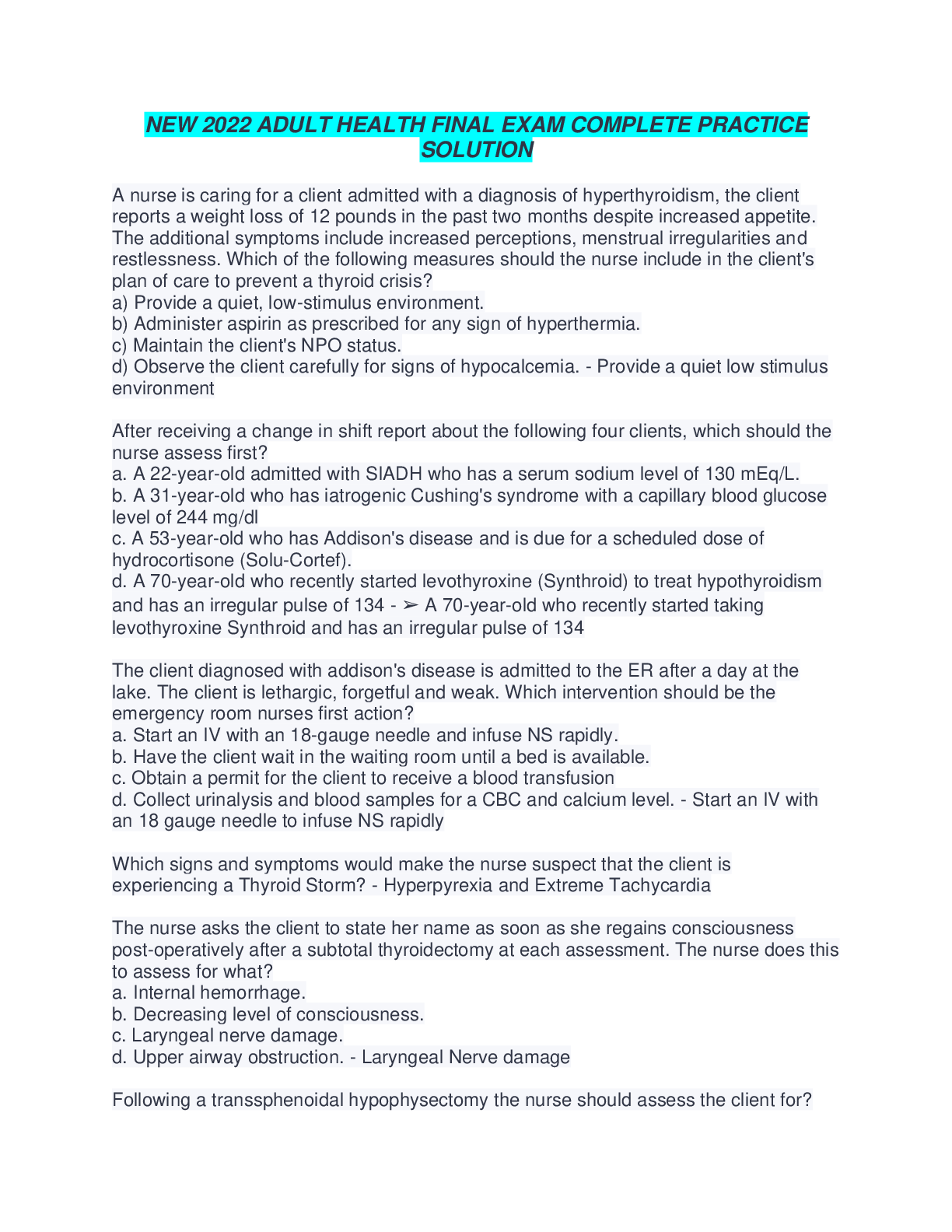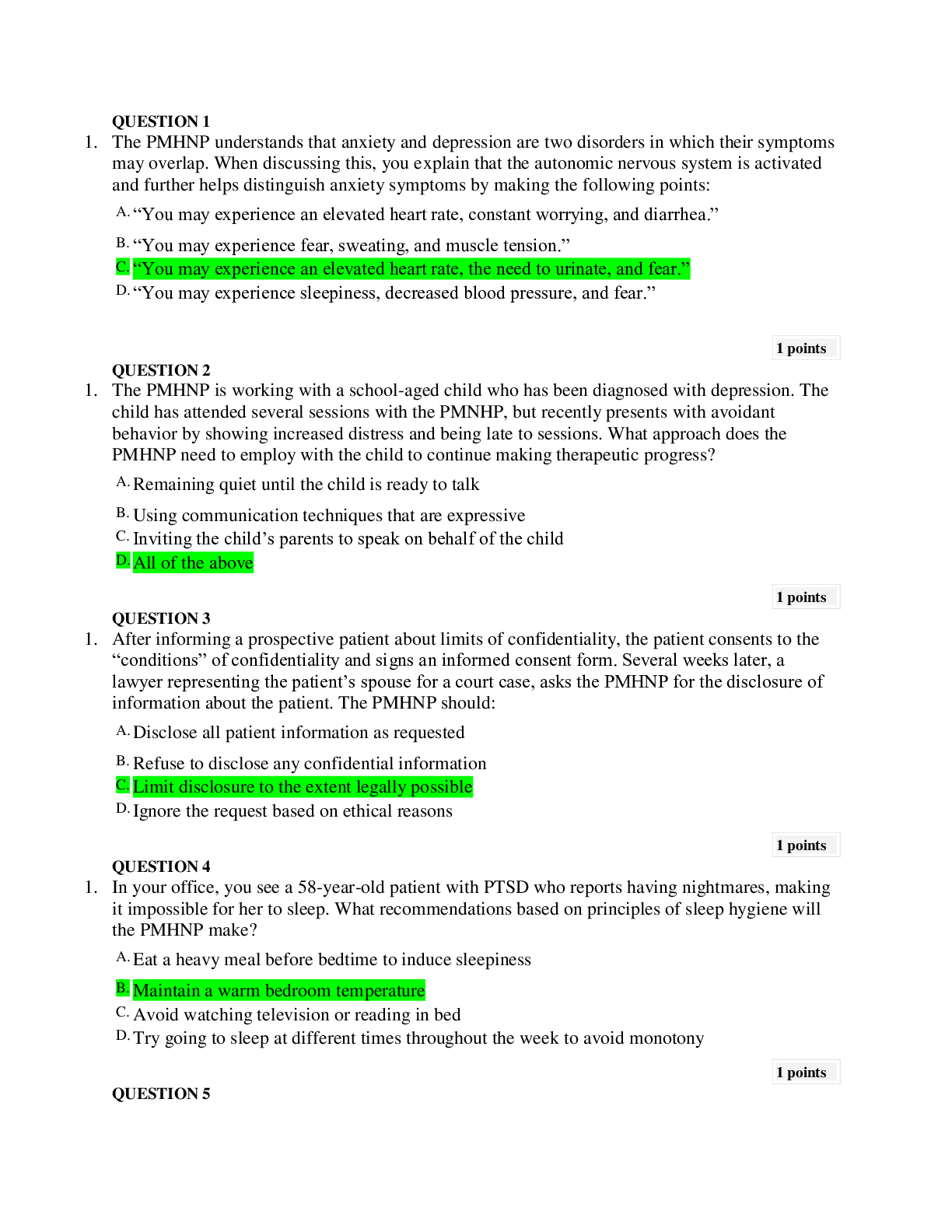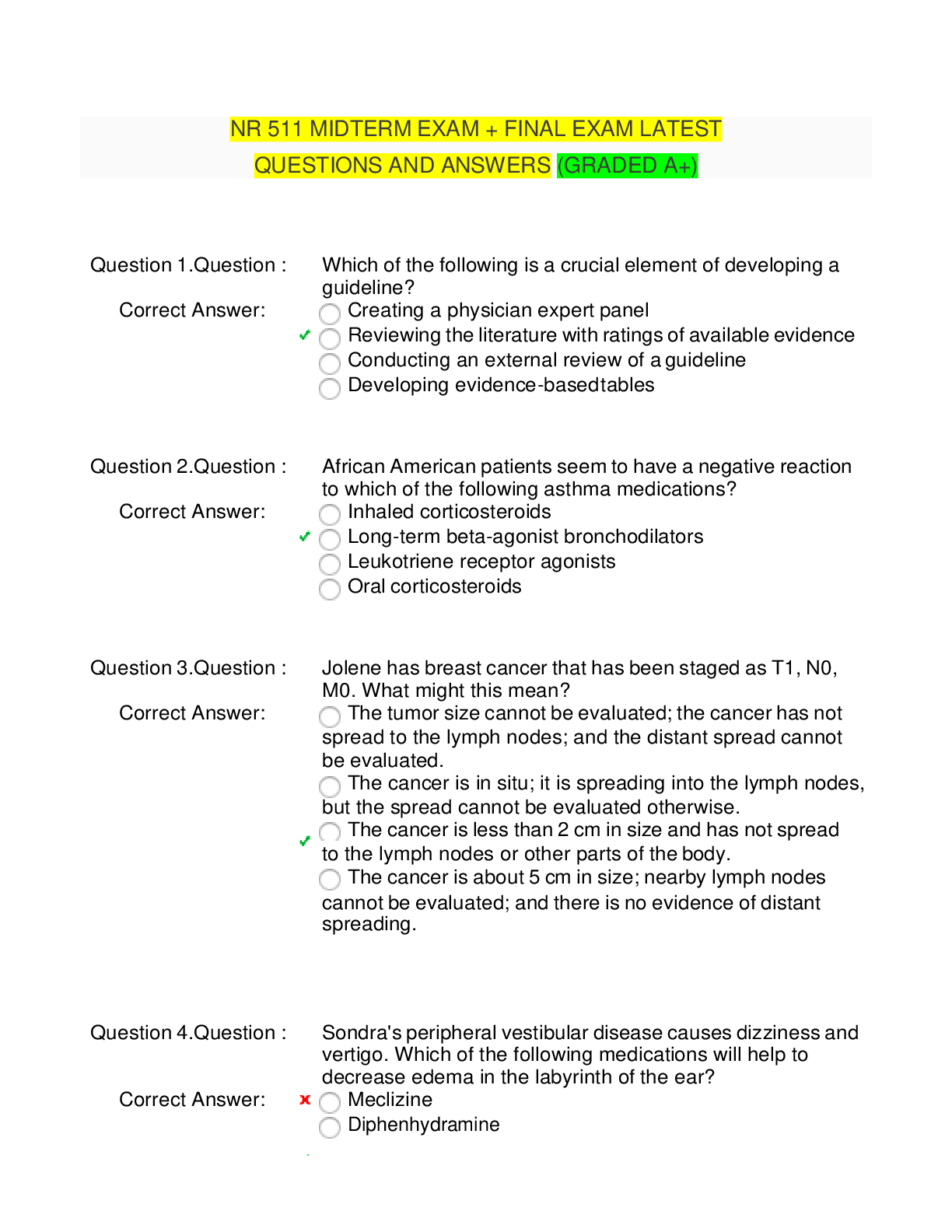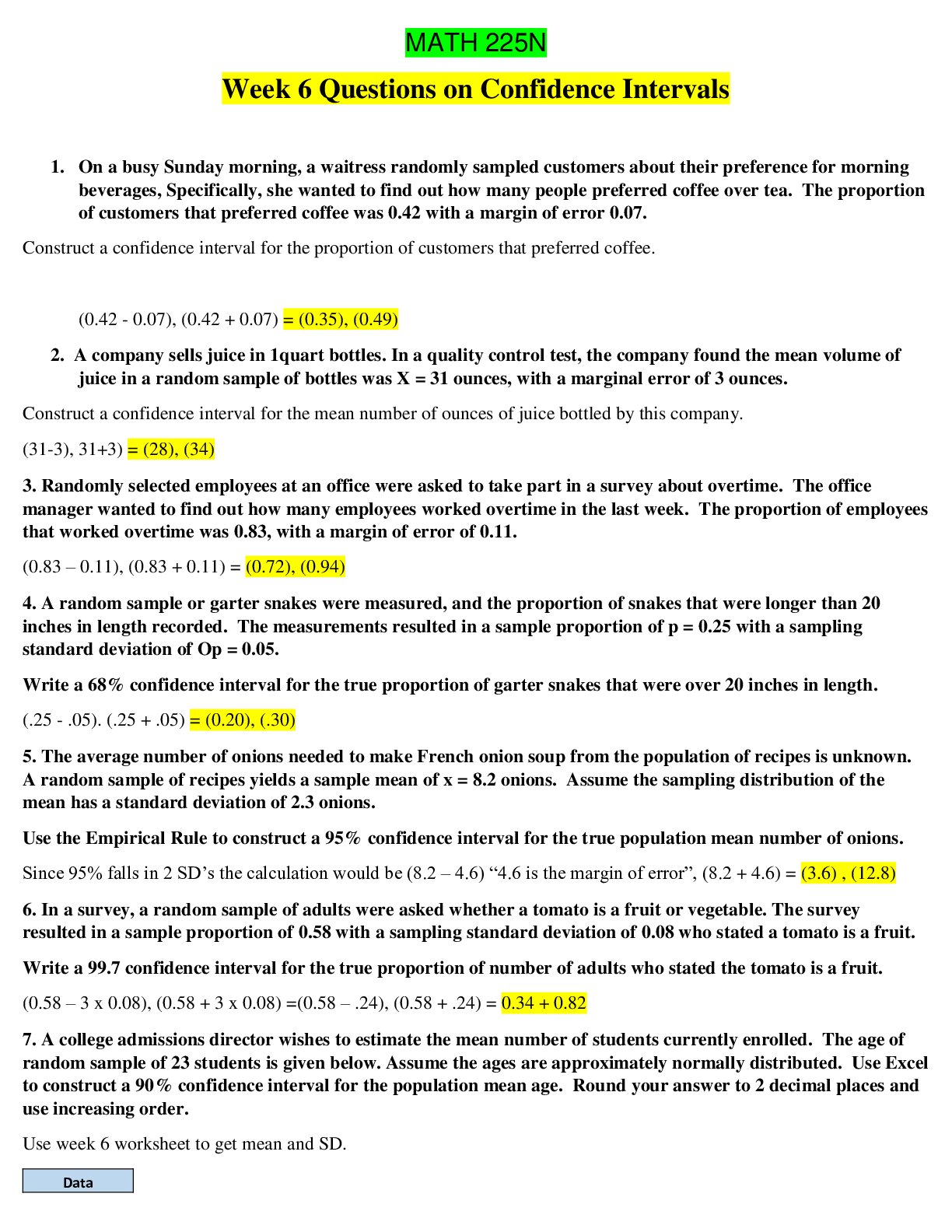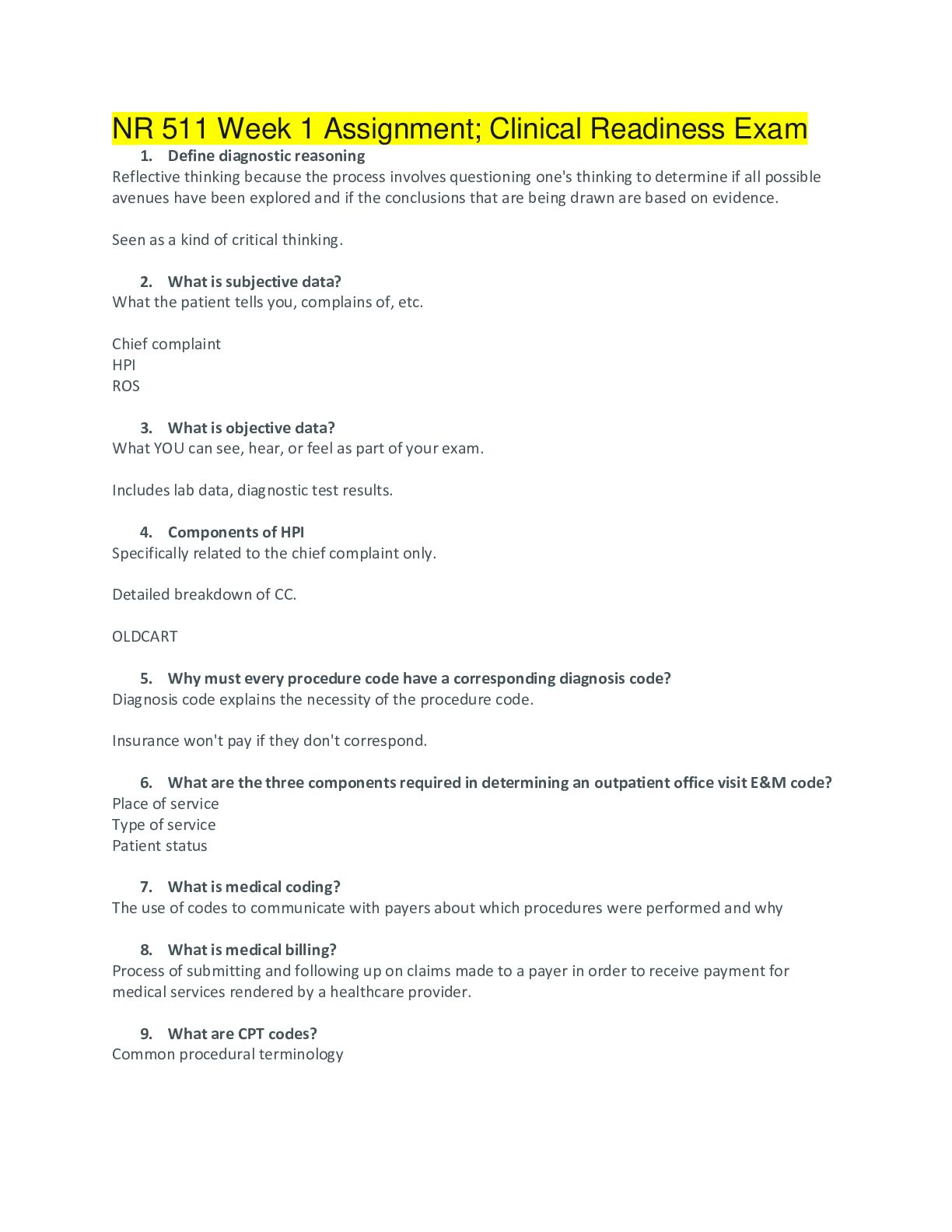Test 3 new practice docs questions and answers solution 2021 docs
Document Content and Description Below
Test 3 new practice docs questions and answers solution 2021 docs Question 1 Your answer is CORRECT. A nerve impulse travels fastest along ________ axons of ______ diameter. a) myelinated, small... b) unmyelinated, small c) myelinated, large d) unmyelinated, large Question 2 Your answer is CORRECT. Ridges of tissue on the surface of the cerebral hemispheres are called ________. a) fissures b) ganglia c) gyri d) sulci Question 3 Your answer is INCORRECT. Consciousness is created in the: a) brainstem b) cerebellum c) cerebral cortex d) hypothalamus Question 4 Your answer is CORRECT. A memory that has lasted over a weekend is described as a: a) short term memory. b) long term memory. Question 5 Your answer is CORRECT. What is the correct order for the parts of the spinal cord, from superior to inferior? a) Cervical - thoracic - sacral - coccygeal - lumbar b) Cervical - thoracic - lumbar - sacral - coccygeal c) Thoracic - lumbar - sacral - cervical - coccygeal d) Thoracic - cervical - lumbar - coccygeal - sacral e) Thoracic - lumbar - sacral - coccygeal - cervical Question 6 Your answer is CORRECT. Nerves and ganglia are structures found in the: a) central nervous system. b) peripheral nervous system. c) both the central and peripheral nervous systems. Question 7 Your answer is CORRECT. A hyperpolarization is when the inside of a neuron becomes _______________ the resting membrane potential. a) more negative than b) less negative than c) closer to Question 8 Your answer is CORRECT. Commissural fibers in the brain mainly connect different regions within the same hemisphere. a) True b) False Question 9 Your answer is INCORRECT. The subarachnoid space lies between what two layers of meninges? a) dura and epidura b) arachnoid and dura c) arachnoid and epidura d) arachnoid and pia Question 10 Your answer is CORRECT. Ependymal cells a) Are responsible for producing cerebrospinal fluid in the CNS. b) Serve as an immune defense cell of the CNS. c) Are responsible for maintaining the spatial relationships between neurons in the CNS. d) Provide myelin sheaths for neurons in the CNS. Question 11 Your answer is CORRECT. The type of transport protein that moves a substance against its concentration gradient is a: a) channel. b) pump. Question 12 Your answer is CORRECT. There are two types of synapses, based on mode of communication. What are they? a) Mechanical and chemical b) Magnetic and physical c) Physical and chemical d) Chemical and electrical e) Mechanical and electrical Question 13 Your answer is INCORRECT. Cerebral lateralization refers to the: a) difficulty in assigning a precise function to a specific region of the cortex. b) generalization that both cerebral hemispheres receive their sensory information from and project motor commands to the opposite side of the body. c) separation of the various lobes of the brain from each other. d) crisscrossing of information between the two hemispheres. e) functional differences between the right and left hemispheres. Question 14 Your answer is CORRECT. Cerebrospinal fluid is formed by the: a) choroid plexus. b) arachnoid villi. c) arachnoid granulation. d) septumpellucidum. e) mesencephalic aqueduct. Question 15 Your answer is INCORRECT. In myelinated axons the voltage-regulated sodium channels are concentrated at the nodes of Ranvier. a) True b) False Question 16 Your answer is CORRECT. The afferent division of the nervous system is also known as the _____ division. a) motor b) cranial c) ganglial d) efferent e) sensory Question 17 Your answer is INCORRECT. A graph of an EPSP would plot time against a voltage trace that would resemble: a) a hill where the high point approaches the threshold value. b) a hill where the high point is the farthest away from the threshold value. c) a valley where the low point approaches the threshold value. d) a valley where the low point is the farthest away from the threshold value. Question 18 Your answer is CORRECT. Broca's area governs the ability to articulate speech. a) True b) False Question 19 Your answer is CORRECT. Gray matter refers to regions of the central nervous system composed primarily of densely packed neuronal cell bodies, whereas white matter consists of bundles of myelinated nerve fibers. a) True b) False Question 20 Your answer is CORRECT. Referencing the above image identify the dendrite. a) 1 b) 2 c) 3 d) 4 e) 5 f) 6 Question 21 Your answer is CORRECT. Which of the following is not true of graded potentials? a) They are short-lived. b) They can be called postsynaptic potentials. c) They can form on receptor endings. d) They increase amplitude as they move away from the stimulus point. Question 22 Your answer is INCORRECT. Which nucleus stimulates the muscles to produce the pattern of arm and leg movements associated with walking? a) Amygdaloid body b) Caudate nucleus c) Putamen d) Globus pallidus e) Claustrum Question 23 Your answer is INCORRECT. This structure contains unmyelinated axons and serves as a communication route between the right and left sides of the gray matter in the spinal cord. a) Gray commissure b) White commissure c) Lateral commissure d) Posterior commissure e) Denticulate ligaments Question 24 Your answer is CORRECT. An example of spatial summation would be: a) two EPSPs from the same presynaptic input occur so closely together in time that they add together or sum b) an EPSP and an IPSP occur simulatenously in time and cancel each other out c) two EPSPs that occur simultaneously from different presynaptic inputs add together or sum d) action potentials occurring in two presynaptic inputs simultaneously converge upon the postsynaptic cell, initiating two different action potentials in the postsynaptic cell. Question 25 Your answer is CORRECT. The blood-brain barrier is reduced or missing from three locations in the brain. Which is not one of these locations? a) Hypothalamus b) Pineal gland c) Cerebrum d) Choroid plexus Question 26 Your answer is CORRECT. During the rising phase of the action potential which of the following is true: a) Voltage-gated Na+ channels are open and sodium is flowing into the cell. b) Voltage-gated Na+ channels are open and sodium is flowing out of the cell. c) Voltage-gated K+ channels are open and potassium is flowing into the cell. d) Voltage-gated K+ channels are open and potassium is flowing out of the cell. Question 27 Your answer is CORRECT. Which of the cranial nerves is the only one to extend beyond the head and neck region? a) Accessory nerve b) Glossopharyngeal nerve c) Trigeminal nerve d) Vagus nerve e) Vestibulocochlear nerve Question 28 Your answer is CORRECT. The thalamus: a) performs preliminary processing of all sensory input on its way to the cortex. b) inhibits muscle tone throughout the body. c) controls thirst, urine output, and food intake. d) plays a role in emotional and behavioral patterns Question 29 Your answer is INCORRECT. The brain ventricle located in the diencephalon is the _____ ventricle. a) third b) lateral c) fourth d) median e) falx Question 30 Your answer is CORRECT. The type of neuron shown in the picture above would be considered to be: a) unipolar b) bipolar c) multipolar d) anaxonic Question 31 Your answer is CORRECT. Which of the following is not a special characteristic of neurons? a) They have extreme longevity. b) They conduct impulses. c) They have an exceptionally high metabolic rate. d) They are mitotic. Question 32 Your answer is INCORRECT. All of the following neuromodulations result in synaptic inhibition, except: a) A decreased amount of neurotransmitter released from the presynaptic cell. b) An increased amount of enzymatic activity within the synaptic cleft. c) A decrease in the number of receptors on the postsynaptic cell. d) All of these are exceptions e) None of these are exceptions. Question 33 Your answer is CORRECT. Which structure is not a part of the brainstem? a) cerebellum b) medulla oblongata c) midbrain d) pons. e) None of these answers Question 34 Your answer is CORRECT. Anterograde transport is the movement of materials from synaptic knobs to the cell body. a) True b) False Question 35 Your answer is INCORRECT. Which functional class of neurons lies entirely within the central nervous system? a) Bipolar neurons b) Sensory neurons c) Interneurons d) Unipolar neurons e) Motor neurons Question 36 Your answer is CORRECT. Saltatory conduction occurs in: a) myelinated axons, where action potentials occur only at neurofibril nodes. b) myelinated axons, where action potentials occur only under the myelin sheath. c) myelinated axons, where action potentials occur continuously down the entire axon. d) unmyelinated axons, where action potentials occur continuously down the entire axon. e) the axon terminal, where full size action potentials occur at the hillock. Question 37 Your answer is CORRECT. During a mugging, a person experiences an extreme level of fear. What portion of the limbic system is responsible for this and other emotional states? a) Cingulate gyrus b) Amygdaloid body c) The fornix d) Mammillary bodies e) Hippocampus Question 38 Your answer is INCORRECT. The main way acetylcholine is cleared from a synapse is by: a) degradation by an enzyme. b) uptake by the postsynaptic cell. c) reuptake by the presynaptic cell. d) being engulfed by a supporting glial cell. Question 39 Your answer is CORRECT. The spinocerebellar pathway is an ascending somatosensory pathway. a) True b) False Question 40 Your answer is INCORRECT. Arrival of an action potential at the synaptic knob results in: a) opening of voltage-gated calcium channels and diffusion of calcium into the synaptic knob. b) opening of voltage-gated calcium channels and diffusion of calcium out of the synaptic knob to the interstitial fluid. c) closure of voltage-gated calcium channels in the synaptic knob membrane. d) opening of chemically gated calcium channels and diffusion of calcium into the synaptic knob. e) opening of chemically gated calcium channels and diffusion of calcium out of the synaptic knob to the interstitial fluid. Question 41 Your answer is CORRECT. Which choice correctly orders the connective tissue wrappings of a nerve, beginning at the outermost layer? a) Perineurium → epineurium → endoneurium b) Perineurium → endoneurium → epineurium c) Epineurium → perineurium → endoneurium d) Epineurium → endoneurium → perineurium e) Endoneurium → perineurium → epineurium Question 42 Your answer is INCORRECT. The type of neuronal circuit that spreads information from one presynaptic neuron to several postsynaptic neurons is a _____________ circuit. a) converging b) diverging c) reverberating d) parallel-after-discharge e) None of the choices is correct Question 43 Your answer is CORRECT. What is the name of the brainstem sensory area that contains axons that project to the cerebral cortex to arouse us from sleep? a) Habenular nucleus b) Reticular activating system c) Mammillary body d) Hippocampus e) Parahippocampal gyrus Question 44 Your answer is CORRECT. After axonal injury, regeneration in peripheral nerves is guided by ________. a) Wallerian cells b) Golgi organs c) Schwann cells d) dendrites Question 45 Your answer is CORRECT. The negative charge established along the nerve cell membrane is due to: a) movement of Na+ into the cell b) movement of proteins out of the cell c) higher permeability of K+ relative to Na+ d) intracellular protein anions e) both (c) and (d) Question 46 Your answer is CORRECT. Which of the following statements about the absolute refractory period are true? a) Is the period of time covered by the rising and falling phase of the action potential. b) Can be overcome with a stronger than normal stimulus. c) Is the result of all available sodium channels being open during the rising phase and being closed and incapable of opening during the falling phase of the action potential. d) Both (a) and (c). Question 47 Your answer is CORRECT. The Wernicke area is the motor speech area of the frontal lobe. a) True b) False Question 48 Your answer is INCORRECT. The neurons that directly innervate skeletal muscles are called: a) first order neurons. b) second order neurons. c) upper motor neurons. d) lower motor neurons. Question 49 Your answer is CORRECT. Information about temperature, proprioception, and pressure from skin, joints, and muscles is conveyed by: a) somatomotor pathways. b) visceromotor pathways. c) somatosensory pathways. d) viscerosensory pathways. Question 50 Your answer is CORRECT. The numerous folds of the cerebellar cortex are called: a) fissures. b) gyri. c) vermis. d) folia. e) petalias. [Show More]
Last updated: 1 year ago
Preview 1 out of 11 pages
Instant download

Buy this document to get the full access instantly
Instant Download Access after purchase
Add to cartInstant download
Reviews( 0 )
Document information
Connected school, study & course
About the document
Uploaded On
Jan 10, 2021
Number of pages
11
Written in
Additional information
This document has been written for:
Uploaded
Jan 10, 2021
Downloads
0
Views
39

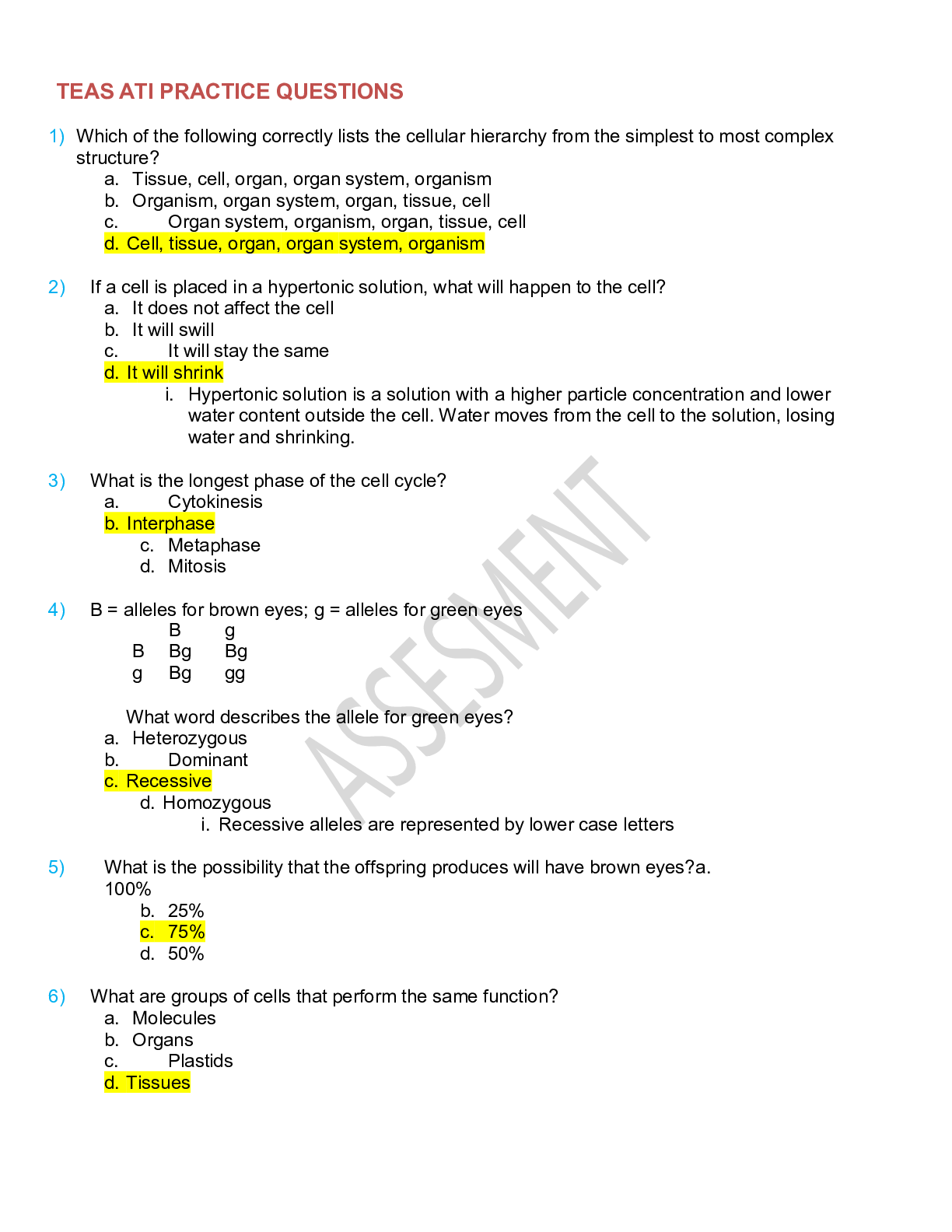



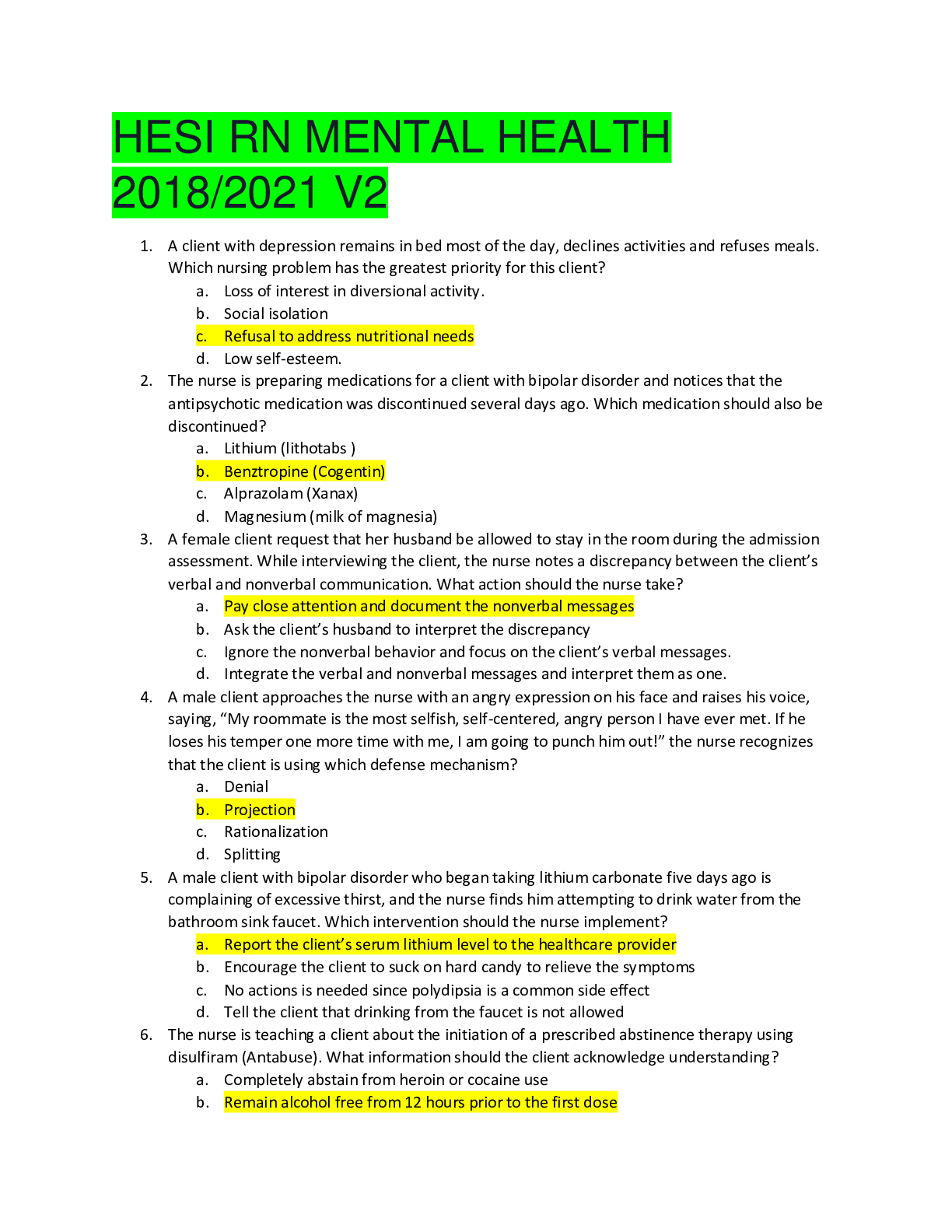
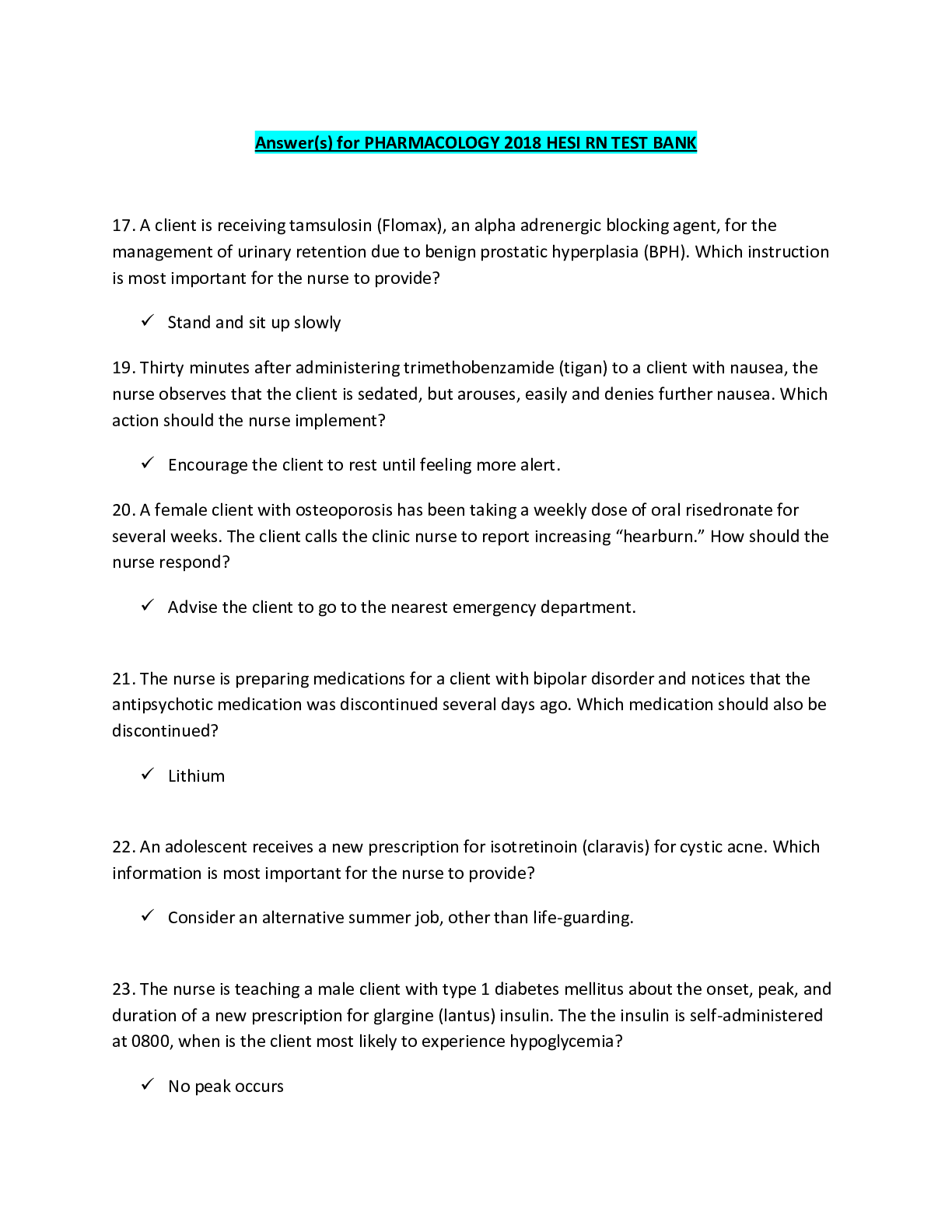

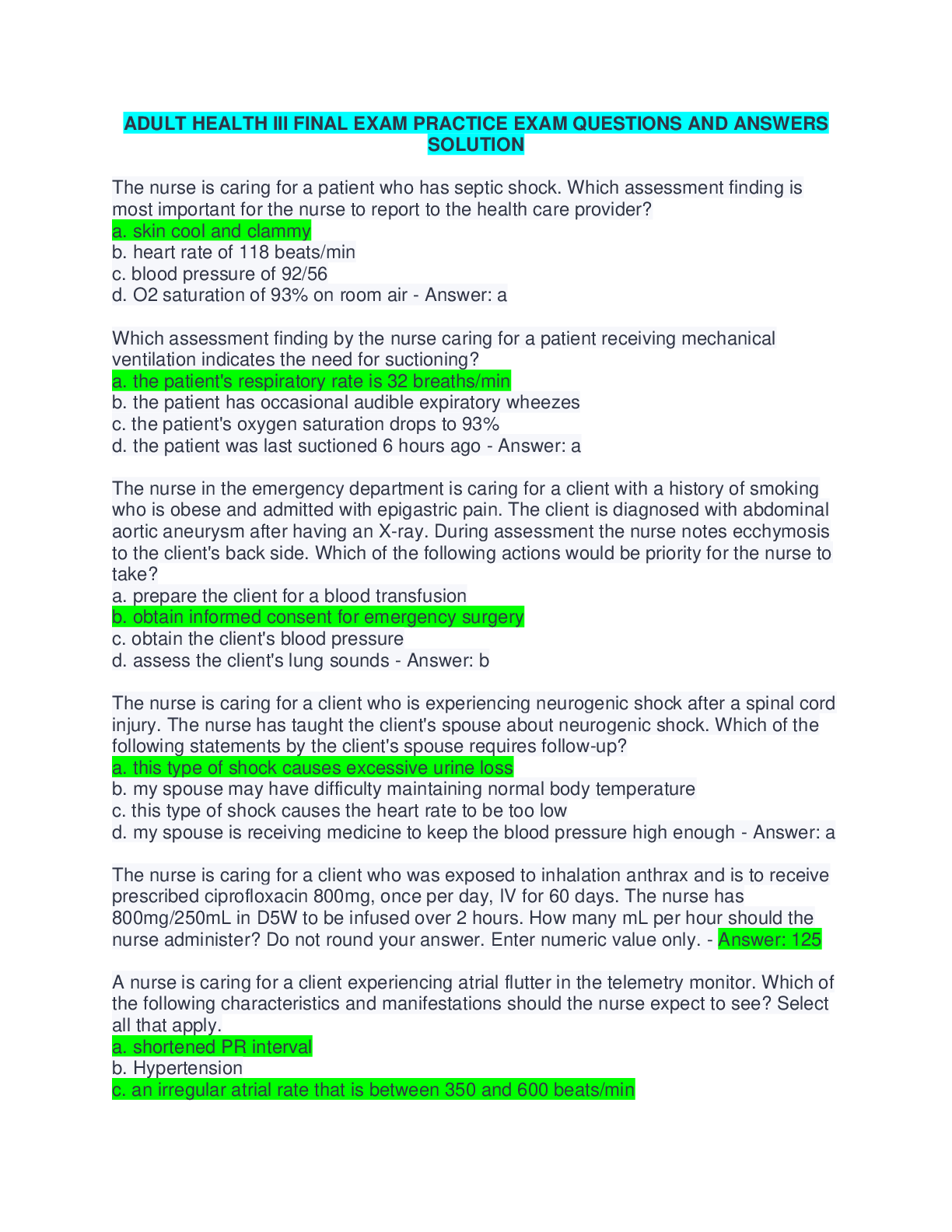


 GRADED QUESTIONS AND ANSWERS.png)
